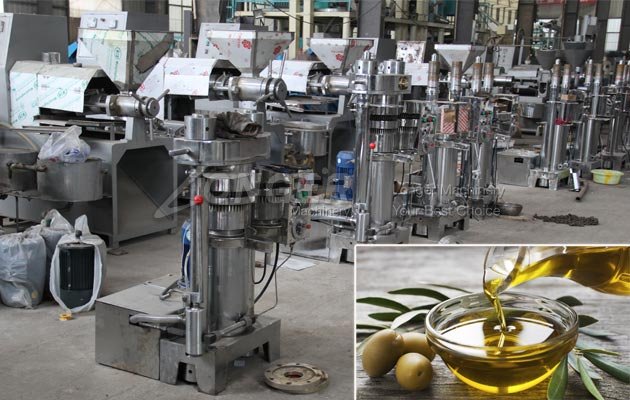Process for cold pressing olive oil with a hydraulic oil press machine:
1. Fruit removal and separation.
Must be mixed in the fruit of the leaves or stones and other debris removed: the classification of good and bad fruit, the first good fruit, while the bad fruit and the fruit is left in the final stage of oil extraction.
Must be mixed in the fruit of the leaves or stones and other debris removed: the classification of good and bad fruit, the first good fruit, while the bad fruit and the fruit is left in the final stage of oil extraction.
2. Cleaning, preheating.
After the fruit is harvested, the olive fruit is placed in a washing tank and rinsed with water to remove dirt, pesticides and various impurities from the fruit. Pick out the fruit and rotten fruit.
When the storage plant temperature is lower than 15°C, the fruit is soaked in a preheated pool at a water temperature of 25-30°C for 10 minutes. The preheated fruit temperature should not exceed 25°C.
3. Smash.
The washed fruit will be crushed for the first time with an anemometer, and the resulting slurry will be crushed. The pulp should be crushed to a uniform degree, and the diameter of the crushed fruit slag should not exceed 4 mm.
4. Fusion.
A sandwich pot with a stirrer should be used. The optimum speed of the stirrer during operation is 20r/min. After stirring the pulp for 50 minutes, the fusion process should be performed through a sandwich pot with hot water at a temperature of 30-35°C, and the heating temperature of the pulp should be maintained within the range of 20-25°C.
5. Cakes, press.
For the 180-type hydraulic oil press, the iron cakes, brown leather, and hand-made cakes are used when laying cakes. The ferrule has an outer diameter of 370mm, an inner diameter of 350mm, and a thickness of 12mm. The cake is filled with 3 iron hoops and one cake. The average thickness of the cake is 220mm and the final thickness is 75mm. 150KG fruit is loaded with 10 cakes wrapped in brown skin. When pushing the pancake press to the hydraulic oil press for squeezing, the big piston should be used first to make the cylinder pressure rise rapidly. When the pressure gauge indicates that the pressure has reached the preset value, the small piston should be switched for squeezing. After the cake is installed, it is fed into the hydraulic oil press and pressed. Use low pressure first, followed by high pressure, then maintain pressure. Holding time 2 ~ 3h.
6. Coarse filter.
The mixed oil extracted from the hydraulic oil press contains moisture and residues and must be separated in time. The simple method is to leave the separation method; or pump into the plate type oil filter for fine filtration; or use a 40 mesh sieve to filter the larger particles in the juice, and then filter the smaller particles in the juice with a 100 mesh sieve. .
7. Decantation.
The coarsely filtered juice is placed in a decantation bucket for oil-water sedimentation and separation, and the decantation temperature is maintained at about 16 to 20° C., and the decantation time is about 5 to 6 hours. After the oil-water layer, the upper layer of oil is discharged from the oil-discharging port to obtain oil with a low moisture content, which accounts for about 85%-90% of the total oil amount.
8. Centrifugation.
A small amount of oil and a large amount of plant water still remaining in the decantation tank can be separated using a centrifugal oil filter to obtain the remaining vegetable oil. Per 100KG olive oil, 20 to 30 kg of olive oil, 35 to 40 kg of olive oil residue, and 35 to 45 kg of vegetable water are available.
9. Vacuum filtration.
The decanted oil and the centrifuged oil were collected and vacuum filtered. When the vacuum oil filter is operated, the degree of vacuum should be maintained at about 0.098 MPa, and the ambient temperature should be maintained between 16 and 20°C.
10. Store.
Vacuum-filtered oil is stored in a storage tank.
Related Products 









